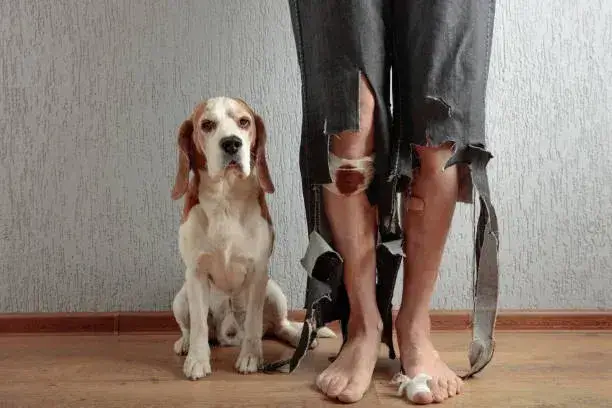For many dog owners, the adorable and sometimes puzzling behavior of their furry companions is a constant source of wonder. One such common canine behavior is scratching or pawing at their human when petting stops abruptly.
While it might appear strange or even frustrating, this behavior serves as a fascinating insight into the complex world of canine communication and affection.
In this article, we will delve into the reasons behind why dogs scratch their owners when they cease petting, exploring the psychology, evolutionary history, and simple gestures that underline this endearing form of communication.
Seeking Attention and Affection
Dogs, like humans, thrive on social interactions and affection. When you pet your dog, you’re offering her the love and attention she craves.
However, once you stop, your dog may not want the affection to end. Scratching or pawing is your dog’s way of expressing, “Hey, I enjoyed that! Don’t stop now; I want more.”
This behavior is akin to a human tapping someone on the shoulder to get their attention or signaling that they desire more affectionate touch.
Reinforcement through Positive Association
Positive reinforcement plays a crucial role in shaping a dog’s behavior. If your dog has learned that scratching or pawing results in receiving more petting, she’s more likely to repeat the behavior.
Dogs are incredibly perceptive and quickly pick up on cause-and-effect relationships. So, if scratching leads to more petting, they will remember this and use the same strategy in the future.
Expressing Displeasure
While scratching often signifies a desire for more attention, it can also be your dog’s way of expressing displeasure at the cessation of petting.
Dogs have preferences too, and they may not want to stop the enjoyable interaction. Some dogs might communicate their dissatisfaction through a gentle scratch, while others might nudge or bark.
Nervousness or Anxiousness
In certain situations, dogs may resort to scratching as a way of coping with nervousness or anxiety.
Petting can be a soothing activity for dogs, and when it stops suddenly, they might become anxious or uneasy. Scratching is a self-comforting behavior that helps them deal with stress and maintain a sense of calm.
Instinctual Behavior
Scratching can also be traced back to the ancestral behavior of dogs and their wild counterparts.
In the wild, dogs and wolves engage in social grooming, which strengthens their bonds and establishes hierarchy within the pack. By scratching you, your dog is reinforcing the bond between you and reaffirming her role as a member of your “pack.”
Communication of Needs
Dogs are adept at non-verbal communication. When they scratch you, it could be their way of communicating various needs.
For instance, they might be indicating that they’re thirsty, hungry, or need to go outside for a bathroom break. Paying attention to other cues, such as body language and vocalizations, can help you better understand your dog’s specific needs.
Habitual Behavior
In some cases, scratching can become a learned, habitual behavior. If a dog has received positive responses to scratching in the past, she might start doing it more frequently, even when the original intention was not necessarily to continue petting.
How to Respond to Your Dog’s Scratching
Now that we understand the reasons behind your dog’s scratching behavior, let’s explore how you can respond appropriately:
Positive Reinforcement: If you don’t mind continuing the petting, respond to the scratching with more affection and attention. This will reinforce the behavior and let your dog know that scratching results in prolonged petting sessions.
Redirect Attention: If you need to stop petting but still want to interact with your dog, offer her a toy or engage in playtime. Redirecting her focus can be a good way to maintain the bond without continuous petting.
Recognize Discomfort: If your dog seems anxious or nervous, consider if there’s something in her environment that could be causing stress. Addressing the underlying cause can alleviate the scratching behavior.
Set Boundaries: While affection is essential, it’s equally important to establish boundaries. Avoid encouraging excessive scratching or pawing that can lead to unwanted behaviors.
Training: Consider training your dog to respond to specific commands, such as “sit” or “stay,” which can help create a structured environment and improve communication.
Conclusion
In conclusion, your dog’s scratching behavior when you stop petting her is a complex interplay of seeking attention, expressing emotions, and instinctual communication.
By understanding the motivations behind this behavior, you can strengthen your bond with your furry companion and respond appropriately to her needs.
Remember that every dog is unique, and paying attention to your pet’s individual cues will help you foster a strong and loving relationship.
So, next time your dog scratches you for more pets, enjoy the special moment of connection and affection that only a canine companion can provide.

